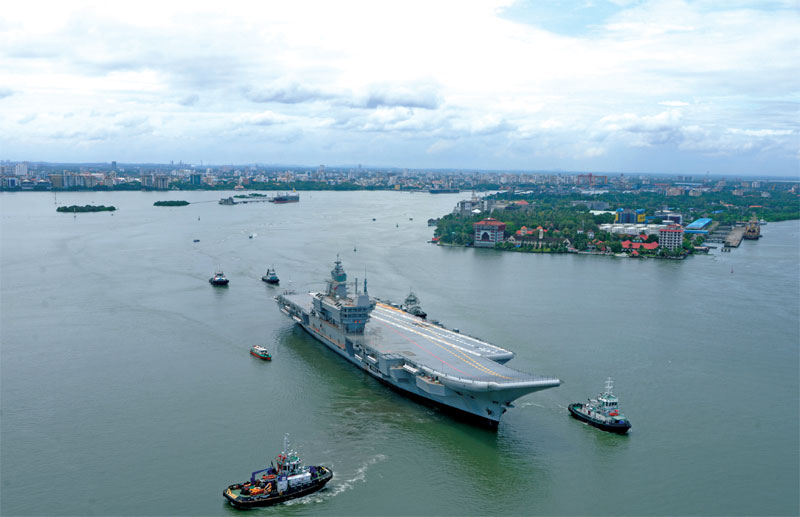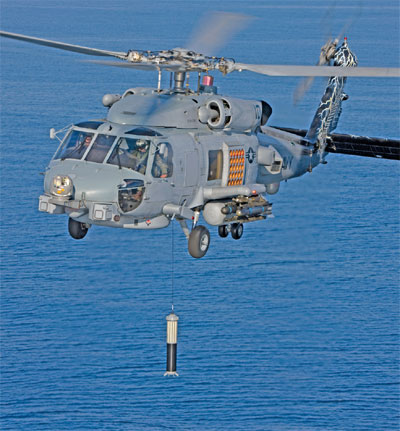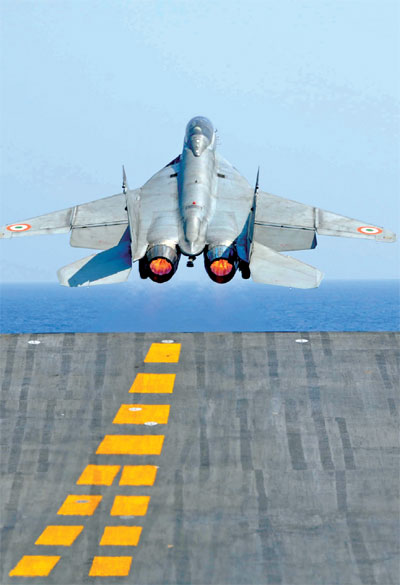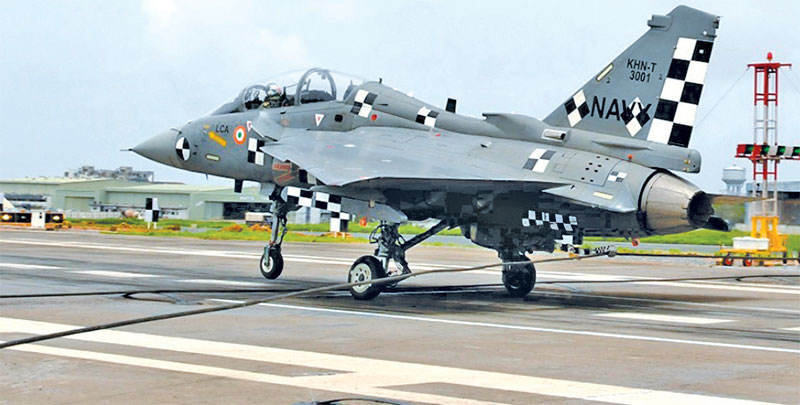Fighters and helicopters for aircraft carrier still to identified, it also doesn’t have dedicated berth yet
 Cmde Anil Jai Singh (retd)
Cmde Anil Jai Singh (retd)
The commissioning of INS Vikrant, India’s first indigenously designed and built aircraft carrier on 2 September 2022, marked a red-letter day for the country. It not only symbolised India’s emerging maritime might and capability, but perhaps more significantly, it showcased the country’s technological and industrial skills. Prime Minister Narendra Modi, in his address on the occasion, rightly highlighted this achievement as a “testament to the hard work, talent, influence and commitment of India in the 21st century.”
Vikrant took 13 years and over Rs 20,000 crore (approximately USD 2.3 bn) to build from the time its keel was laid on 28 February 2009, by defence minister A K Antony and nine years from its launch by Ms Elizabeth Antony on 12 August 2013. The need for the carrier had been recognised in the 1980s itself though its planned size, configuration and nomenclature kept waxing and waning, coincidentally, with the vicissitudes of the Indian economy.
Finally, work on the ship got under way in right earnest in the first decade of the 21st century. Even though the chairman and managing director of Cochin Shipyard candidly acknowledged that “I don’t say 13 years is the best, we can definitely do better. But we must also understand that we were doing it for the first time, so I am not unhappy.” The criticism from various quarters regarding the time taken or the considerable increase in cost over the years is not entirely justified. One must appreciate that an aircraft carrier is an extremely complex system and since this was the first time an indigenous construction was being undertaken in the country, there was far more to it than just building of the ship.

Home Grown
Firstly, unlike many other platforms that have been built for the first time in the country, there was little or no foreign involvement either in the actual build process or in the availability of a proven design. Therefore, at the design stage itself, this was the first ever attempt of its kind and must have led to numerous challenges being faced at every stage of the process and during its subsequent validation prior to the commencement of construction.
Secondly, it was not only about building the platform. The emphasis on indigenisation meant that the option to source proven equipment from foreign suppliers was very limited. In this case a full eco-system, including Tier 1,2 and 3 Indian sub suppliers, had to be identified and developed who understood the complexity of an aircraft carrier and had the ability to deliver equipment which met the exacting quality standards demanded by the platform. To put things in perspective, more than 100 Indian OEMs and MSMEs and over 500 contractors and ancillaries, besides the foreign OEMs, were involved in supplying the equipment. Qualifying these suppliers would have been time consuming and ensuring its completion within a limited time would have been equally challenging. Further, testing, acceptance and installation of the equipment on board the platform would also not have been an easy task since this was the first ever attempt. It is understood that there were delays in the delivery of some of the foreign equipment.
Just to give a broad idea of the magnitude of the task, Vikrant is 262 metres long, displaces more than 40,000 tonnes and has more than 10 decks. Its total cabling is about 2,600 kms long and it has more than 2,200 compartments and machinery spaces on board. It has the logistic wherewithal to accommodate and sustain a crew of around 1,600 personnel when all the aviation squadrons are embarked on board.
Overcoming challenges

The crew, the overseeing team and the shipyard staff that put the carrier through its paces during the testing and trial phase would have encountered major and minor defects and numerous problems which needed to be rectified until the exact specifications were met and thereafter to move on to the next stage. Integrating different equipment sourced from various parts of the world, including weapons, sensors, aviation facilities, the platform management system and the command and control architecture, into a composite whole on such a large and complex platform would have tested the calibre of many on board. It is to the credit of the entire team that on its very first sea trial, Vikrant was able to achieve maximum speed. This is an achievement that even navies with decades of experience in aircraft carrier construction cannot boast of and is a testimony to the skills of the personnel involved at every step of the way.
It is also to the credit of all those involved in building the ship within and outside the shipyard that, despite the debilitating effects of the pandemic when life virtually ground to a halt particularly where a physical presence at work was an imperative, the delays were kept to the barest minimum and the ship continued with its fitting out, basin trials, harbour trials etc., to be ready for the first sea trials which took place in August 2021.
With its successful commissioning behind her and a full crew now on board, the inevitable question is, what next?
Immediate Tasks
The two immediate tasks before Vikrant are for it to become a fully combat capable platform, including its flight operations and its integration into fleet operations. The main task before the Indian Navy is to ensure adequate force levels to simultaneously deploy two fully equipped Carrier Battle Groups.
INS Vikrant, as she is now officially called, has still some way to go before she becomes fully combat capable and gets fully integrated with the fleet. There are still some important systems, including weapons and sensors, that are yet to be installed. The ship will probably be required to dock soon for the installation of the Long Range Surface to Air Missile System (LRSAM), and the Israeli origin Multi-Function Surveillance, Track And Guidance Radar (MF Star radar). The LRSAM is an important weapon on board as it provides the carrier an area air defence capability to defend itself from a missile or air attack at a longer range. The ship is also fitted with 76mm guns and the AK630 gun system for close in air defence. It also has a Kavach chaff based decoy to shield it against incoming missiles.
Perhaps the single greatest threat to an aircraft carrier is from the ocean depths with the hydrological profile of the Indian Ocean being inherently favourable to submarine operations. While a threat from an incoming aircraft or even a missile is detectable, a submarine is more often than not able to successfully approach its target undetected to within its weapon firing range. The size of the carrier makes it even more vulnerable. Hence, to thwart a torpedo attack from an enemy submarine that may have successfully penetrated the ASW screen around the carrier, Vikrant will be equipped with a passive Anti-Submarine Warfare (ASW) system incorporating a sonar with an integrated launcher and decoy system.
It is also understood that the aviation facilities complex, developed with Russian assistance, is also not fully operational as yet. The vice chief of the naval staff at a recent media interaction has estimated that the ship’s flight trials will commence by November 2022 and should be completed by mid-2023. Hence full-fledged operational flying is likely to commence in the latter half of 2023. Besides these critical elements, there may also be many other equipment which are yet to be fully operationalised or integrated and remain a work in progress. All these will have to be in place and fully operational within the same time frame.
Crew Involvement

One of the biggest advantages in indigenous shipbuilding is the involvement of the crew from an early stage itself. In many foreign shipyards, a shipyard crew mans the ship through the initial trials and hands over to the navy after a certain stage of equipment acceptance and trials have been completed. But in India a major part of the crew is closely associated with the equipment from the very installation stage itself and remains so through its setting to work, harbour trials, sea trials and final acceptance. Therefore, by the time the ship commences sea trials and nears its commissioning date, the crew is already familiar with the operation and the maintenance of the equipment and the platform. This saves valuable time in training and work-up once the ship is commissioned and enables a seamless transition from trials to operations.
That notwithstanding, it is only after commissioning that the ship is under naval control and with its full crew embarked, it can focus on the finer aspects of full system integration and work-up as a naval war fighting platform. Similarly, the full operationalisation of the aviation complex on board is a pre-requisite for undertaking flight operations and this is possible once all flight safety aspects are in place and are controlled by the crew.
Vikrant is expected to embark on a complement of about 30 fixed wing and rotary wing aircraft. The ship has been configured to operate with the naval version of the indigenously built Light Combat Aircraft and complemented by the Russian MiG29K fighter, which operates from the other aircraft carrier, INS Vikramditya. But in the absence of the operationalised LCA Mk 2 (the naval version), the only fighter aircraft available in the naval inventory is the MiG29K, which, despite its limited numbers, will have to do service on both the aircraft carriers. The Hindustan Aeronautics Ltd is in the process of designing a carrier-borne fighter aircraft, referred to as the TEDBF (Twin Engined Deck-based Fighter), which is optimistically estimated to be operational by the end of this decade.
Aircraft & Choppers
In the meantime, the Indian Navy is planning to acquire 26 fighter aircraft from abroad as an interim measure to tide over this delay in the availability of an indigenous solution. Recent reports indicate that the choice has narrowed down to the US-built Boeing F-18 Hornet or the French Rafale-M. Both these aircraft have undergone trials in India and a decision on which of these is selected should soon be forthcoming.
The rotary wing element will primarily comprise the Kamov 31 Airborne Early Warning (AEW) helicopter, the Sikorsky MR-60H Multi-Role helicopter (MRH) and limited availability of the old war horses, the Chetak and the Seaking Mk 42. After many years of discussion on the indigenous manufacture of 116 Naval MRH not making any headway, 24 of these are being directly imported from the US, the delivery of which is likely to continue till 2025. This number is grossly inadequate to meet even the navy’s existing requirements on board its frontline surface combatants, leave alone being sufficient for two aircraft carriers. The navy’s helicopter procurement saga is typical of much of the decision making in the ministry of defence. The indigenous manufacture of 114 Naval Utility Helicopters, proposed under the strategic partnership model, continues to languish in South Block as does the MRH. The irony is that despite it having taken 13 years to build Vikrant, the Indian defence decision making apparatus has not been able to make an informed decision on the acquisition of enough aircraft to be sufficient for a two-carrier navy.
There is also the unfinished business of berthing Vikrant. It has been decided to base her on the East Coast to ensure the availability of a Carrier Battle Group on the country’s west and east. But there is presently no suitable berth available at any naval harbour so Vikrant is likely to be berthed at the Larsen and Toubro facility at Katupalli, north of Chennai, till such time suitable naval facilities to berth a carrier are established. This mismatch in planning should have been avoidable. In 17 years, from 2005 when the steel was first cut to the carrier’s commissioning in 2022, suitable berthing facilities and shore infrastructure for berthing an aircraft carrier could have been built. While there may be very good reasons for why this could not be done, it does seem odd that such a high value platform has to be berthed at a makeshift commercial facility.

Big Question
The bigger question though, is the ability of the Indian Navy to simultaneously deploy two full-fledged Carrier Battle Groups. CBGs are composite fighting formations with a multidimensional capability. They have the dual advantage of high mobility (they can transit up to 500 nautical miles in a single day), coupled with the ability to deliver devastating kinetic effect. With two aircraft carriers now a reality and the navy highlighting the requirement for a third, the commensurate fleet strength will also need to be augmented. The navy has a robust ship building programme; at last count, the Chief of Naval Staff mentioned that 39 ships and submarines are presently under construction and another 49 have been accorded acceptance of necessity (AoN) by the MoD. The Navy Chief has also articulated a fleet strength of 175 ships by 2027.
Of these, the blue water element will comprise destroyers, frigates, corvettes, LPDs, under way replenishment ships and in a limited role, armed offshore patrol vessels as well. While the addition of the four Project 15B destroyers will help maintain the current force level of 10 destroyers, there will be a significant addition to the frigate fleet with the addition of seven P-17A stealth frigates and four Type 1135.6 frigates. Similarly, there will be a substantial increase in the replenishment capability enabling longer reach and improved sustainability at sea. It is therefore expected that by 2027 the number of surface platforms will be sufficient to support two CBGs.
But ensuring the availability of an adequate air element may take longer. The government has also acknowledged the requirement for six nuclear powered attack submarines (SSN), which are an integral part of a CBG in the contemporary maritime battlespace. But that programme is not progressing satisfactorily enough and the first indigenous submarine is unlikely to enter service before 2035-2040.
With the changing nature of naval warfare and an increasingly networked battlespace environment, the future will be about far more than just the number of hulls. But their importance cannot be undermined. Navies all over the world continue to invest in high-end war fighting platforms (our northern neighbour being the prime example) and so should we. It will be the ability of conventional naval forces to exploit autonomous and unmanned platforms and disruptive technologies as effective force multipliers that will make the difference. The Indian Navy will therefore have to be nimble, agile and flexible to deftly adapt to this emerging paradigm to retain its combat edge.
(The writer is vice president, Indian Maritime Foundation)

